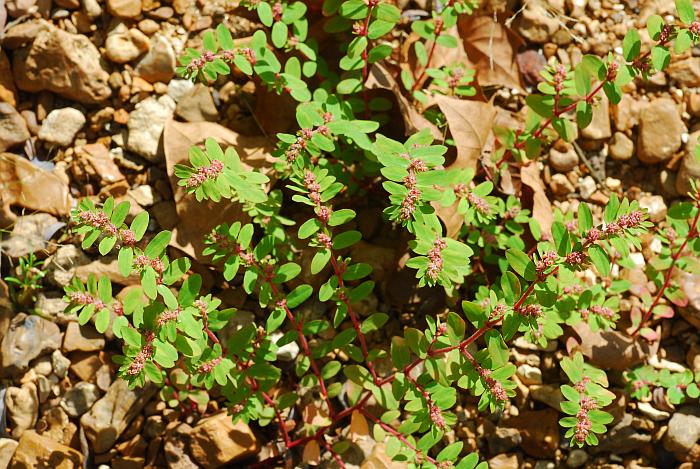Euphorbia humistrata Engelm.
Spurge

Native
CC = 3
CW = 0
MOC = 35
© SRTurner
Euphorbia humistrata Engelm.Spurge | |
 |
Native CC = 3 CW = 0 MOC = 35 |
© SRTurner |
|
Family - Euphorbiaceae Stems - To 45 cm, on taproot, prostrate or sometimes ascending, branched and mat-forming, moderately to densely pubescent, especially toward the tips, the hairs often in two bands along opposite sides of the stem.
Leaves - Opposite, sessile or nearly so. Stipules small scales to 1.5 mm long, those from the adjacent leaf in each pair often fused into a single, small, scalelike structure on each side of the stem. Leaf blades 5-17 mm long, roughly oblong, asymmetric at the base with the side toward the stem tip usually angled and the other side more or less truncate, usually rounded at the tip, the margins minutely few-toothed (best observed with magnification), the upper surface glabrous or nearly so, the undersurface glabrous or sparsely pubescent and usually silvery to pale grayish green.
Inflorescence - Inflorescences axillary, of solitary cyathia or appearing as small clusters on short axillary branches.
Cyathia - Involucre 0.6-1.0 mm long, sparsely hairy, the rim shallowly 4-lobed or 4-toothed, the marginal glands 4, 0.1-0.5 mm long, the body narrowly oblong to nearly linear, reddish purple to dark purple, with a relatively inconspicuous petaloid appendage 0.1-1.0 mm long, this white to strongly pinkish- or reddish-tinged. Staminate flowers 3-8 per cyathium. Ovaries hairy, the styles 0.5-0.8 mm long, each divided about 1/2 of the way from the tip into 2 slender lobes.
Fruits - Fruits 1.0-1.5 mm long, evenly pubescent with appressed or strongly incurved hairs. Seeds 0.8-1.2 mm long, oblong-ovate in outline, the surface smooth or appearing finely roughened, lacking cross-ridges, white to reddish brown. Flowering - June - October. Habitat - Riverbanks, sloughs, pond margins, levees, roadsides, open disturbed areas. Origin - Native to the U.S. Other info. - This is one of about ten species in a group which has been segregated by some authors into the genus Chamaesyce. They tend to be small, low to the ground or prostrate, inconspicuous and often weedy. Identification to species usually requires attention to minute details of stem, styles, and fruits, and in some cases can be quite difficult. The population shown in the photos above is somewhat unusual for having very red stems; in this species the stems are more often greenish. The upper surface of the leaves usually lacks the reddish spot which is common in some other species, but again this is not a reliable species diagnostic. Photographs taken at Catawissa Conservation Area, Franklin County, MO, 9-4-2018; and at Shaw Nature Reserve, Franklin County, MO, 8-26-2021 (SRTurner). |